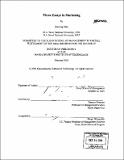Three essays in marketing
Author(s)
Shin, Jiwoong, 1971-
DownloadFull printable version (5.993Mb)
Alternative title
3 essays in marketing
Other Contributors
Sloan School of Management.
Advisor
Duncan Simester.
Terms of use
Metadata
Show full item recordAbstract
(cont.) that threaten to disappear cause decision makers to invest more effort and money in order to keep these options open, even when the options themselves seem to be of little interest. The last experiment provides initial evidence that the mechanism underlying the tendency to keep doors open is a type of loss aversion rather than a desire for flexibility. The first essay studies the credibility of non-commitment advertising. To attract potential customers, retailers often advertise low prices with appeals such as Prices start at $49 or One week in the Caribbean from $449. We offer here an explanation of how such advertisements can construct a credible price image in the absence of any commitment based on the role of selling costs. When retailers must incur costs in the process of selling a product, advertising low prices to lure potential consumers can backfire. This is so because attracting too many consumers who are less likely to purchase the retailer's higher priced products imposes unwanted selling costs, but yields little extra revenue. We show analytically that such advertising can be credible only when there is a substantial difference in retailers' cost types or the selling cost is high. The second essay analyzes the free-riding problem under the situation where the selling costs are high. Intuitively, we can expect that free-riding will hurt the retailer who provides service. Nonetheless, we analytically show that free-riding actually benefits not only the free-riding retailer, but also the retailer who provides service. The intuition behind this result is that by allowing free-riding, the service provider can induce a softer re-action from its competitor who now enjoy free-riding. Therefore, allowing free-riding can be regarded as a strategic investment which prevents an aggressive response from the other retailer. The third essay adopts an experimental approach to the study of incentives. The question asked in this work is whether a threat of disappearance changes the way such options are valued. In four experiments using door games, we demonstrate that options
Description
Thesis (Ph. D.)--Massachusetts Institute of Technology, Sloan School of Management, February 2005. Includes bibliographical references.
Date issued
2005Department
Sloan School of ManagementPublisher
Massachusetts Institute of Technology
Keywords
Sloan School of Management.